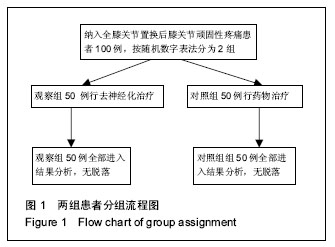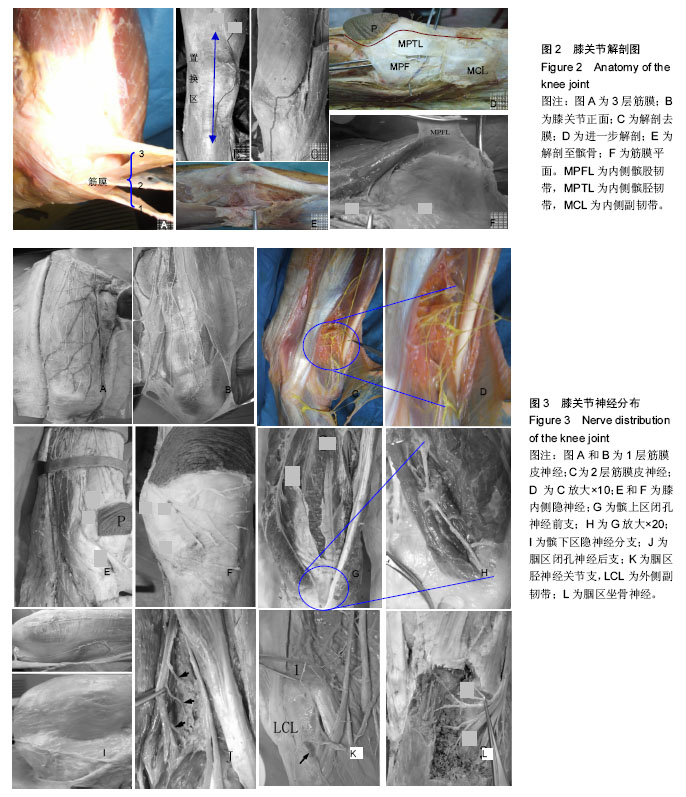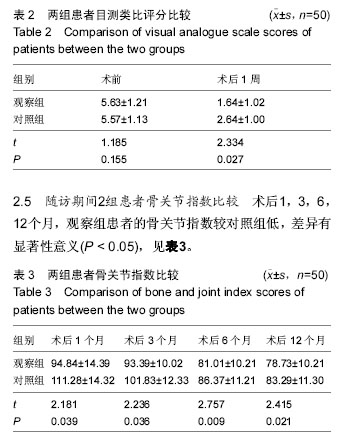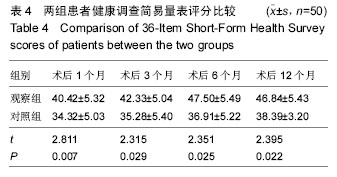中国组织工程研究 ›› 2016, Vol. 20 ›› Issue (31): 4589-4595.doi: 10.3969/j.issn.2095-4344.2016.31.004
• 人工假体 artificial prosthesis • 上一篇 下一篇
去神经化治疗膝关节置换后膝关节顽固性疼痛
马松鹤
- 河南省人民医院疼痛科,河南省郑州市 450000
Denervation therapy for intractable pain of knee joint after total knee arthroplasty
Ma Song-he
- Department of Pain, Henan Provincial People’s Hospital, Zhengzhou 450000, Henan Province, China
摘要:
文章快速阅读:
.jpg)
文题释义:
膝关节置换后顽固性疼痛:如何治疗膝关节置换后顽固性疼痛成为一大难题。有研究者猜测这些疼痛是源于神经痛,因为在膝关节置换过程中,不可避免地会对膝关节周围的皮神经造成不同程度的损伤。但是目前关于这些不明原因的顽固性疼痛是否源于神经痛,目前临床存在诸多争议。
去神经治疗:国际上认为原因不明的膝关节疼痛是神经源性的,是由手术过程中患者的神经受到损伤引起神经卡压、神经牵拉等。由于解剖在临床得到广泛运用,根据解剖结果切除膝关节置换后膝关节顽固性疼痛患者的相关皮神经,进而缓解患者的疼痛,取得了较为满意的效果。
摘要
背景:国内关于膝关节周围皮神经的解剖研究较少,国内治疗膝关节置换后顽固性疼痛多采用翻修手术或长期服用药物缓解疼痛,但这2种方法并不能有效缓解患者的术后疼痛。
目的:通过对膝关节的解剖,明确人体膝关节周围皮神经分布,探究去神经化方案对膝关节置换后膝关节顽固性疼痛患者的治疗效果。
方法:对2具成年防腐尸体和2具新鲜成年尸体进行解剖,观察膝骨关节周围皮神经组织分布。选择全膝关节置换后膝关节顽固性疼痛患者100例,随机分为2组,每组50例。观察组根据解剖结果进行去神经化治疗,对照组采用药物治疗。对患者进行术后随访,采用骨关节指数评估患者膝关节功能,采用健康调查简易量表(SF-36)评估生活质量,采用目测类比评分评估疼痛情况,并记录不良反应。
结果与结论:①膝关节周围的皮神经分布较为固定,且各个皮神经均有较为明确的骨性标志,可以为有关手术提供解剖依据;②术后观察组患者目测类比评分显著低于对照组(P < 0.05);③术后1,3,6,12个月,观察组患者的骨关节指数较对照组低,健康调查简易量表SF-36评分较对照组高(P < 0.05);④观察组患者术后出现3例关节肿胀,对照组患者2例出现关节肿胀,2组比较差异无显著性意义(P > 0.05);⑤通过尸体解剖可明确膝关节周围皮神经的解剖分布,在此基础上进行的去神经化治疗能够有效改善膝关节置换后膝关节顽固性疼痛患者的疼痛症状和骨关节质量,提高患者的生活质量,且具有较好的安全性。
中国组织工程研究杂志出版内容重点:人工关节;骨植入物;脊柱;骨折;内固定;数字化骨科;组织工程
ORCID: 0000-0001-6546-3899(马松鹤)
中图分类号:





.jpg)